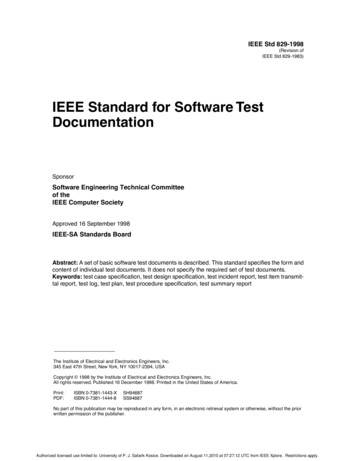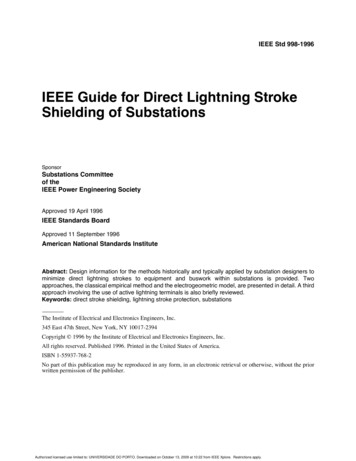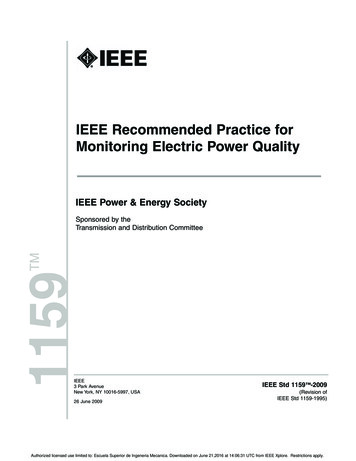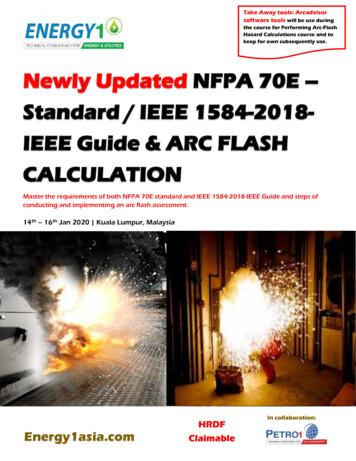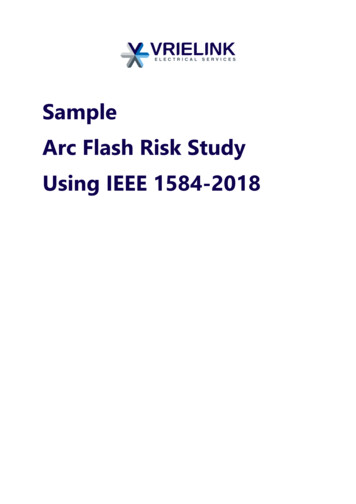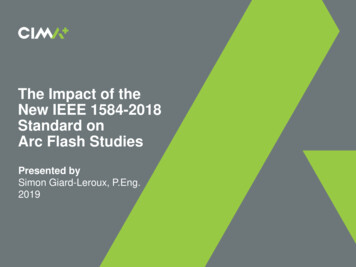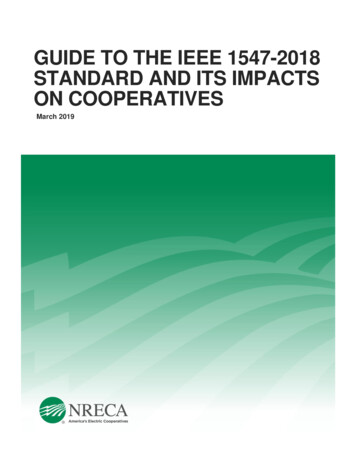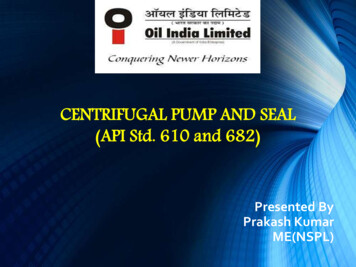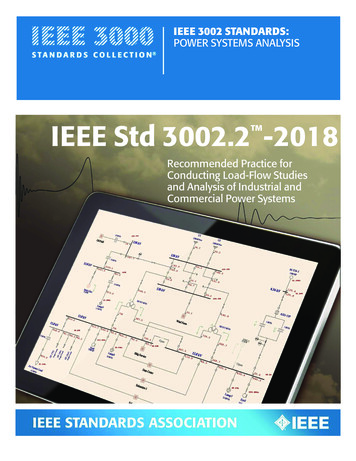
Transcription
IEEE 3002 STANDARDS:POWER SYSTEMS ANALYSISIEEE Std 3002.2 -2018 Recommended Practice forConducting Load-Flow Studiesand Analysis of Industrial andCommercial Power Systems
IEEE Std 3002.2 -2018IEEE Recommended Practice for ConductingLoad-Flow Studies and Analysis ofIndustrial and Commercial Power SystemsSponsorTechnical Books Coordinating Committeeof theIEEE Industry Applications SocietyApproved 27 September 2018IEEE-SA Standards Board
Abstract: Activities related to load flow analysis, including design considerations for new systems,analytical studies for existing systems, as well as operational and model validation considerationsfor industrial and commercial power systems are addressed. Load flow analysis includes steadystate power flow and voltage analysis along with considerations for optimal power flow calculations.The use of computer-aided analysis software, with a list of desirable capabilities recommendedto conduct a modern load-flow study, is emphasized. Examples of system data requirements andresult analysis techniques are presented.Keywords: cable ampacity, compensation, convergence, demand factor, electrical losses,Gauss-Seidel, generation, IEEE 3002.2, impedance, industrial loads, industrial power system,load flow analysis, load-flow studies, Newton-Raphson, overload, over voltage, power demand,power factor correction, power flow, system validation, under voltage, voltage drop, voltageprofile, voltage riseThe Institute of Electrical and Electronics Engineers, Inc.3 Park Avenue, New York, NY 10016-5997, USACopyright 2018 by The Institute of Electrical and Electronics Engineers, Inc.All rights reserved. Published 12 November 2018. Printed in the United States of America.IEEE is a registered trademark in the U.S. Patent & Trademark Office, owned by The Institute of Electrical and Electronics Engineers,Incorporated.PDF:Print:ISBN 978-1-5044-5240-3ISBN 978-1-5044-5241-0STD23360STDPD23360IEEE prohibits discrimination, harassment, and bullying.For more information, visit http:// www .ieee .org/ web/ aboutus/ whatis/ policies/ p9 -26 .html.No part of this publication may be reproduced in any form, in an electronic retrieval system or otherwise, without the prior written permissionof the publisher.
Important Notices and Disclaimers Concerning IEEE Standards DocumentsIEEE documents are made available for use subject to important notices and legal disclaimers. These noticesand disclaimers, or a reference to this page, appear in all standards and may be found under the heading“Important Notices and Disclaimers Concerning IEEE Standards Documents.” They can also be obtained onrequest from IEEE or viewed at http:// standards .ieee .org/ IPR/ disclaimers .html.Notice and Disclaimer of Liability Concerning the Use of IEEE StandardsDocumentsIEEE Standards documents (standards, recommended practices, and guides), both full-use and trial-use,are developed within IEEE Societies and the Standards Coordinating Committees of the IEEE StandardsAssociation (“IEEE-SA”) Standards Board. IEEE (“the Institute”) develops its standards through a consensusdevelopment process, approved by the American National Standards Institute (“ANSI”), which bringstogether volunteers representing varied viewpoints and interests to achieve the final product. Volunteersare not necessarily members of the Institute and participate without compensation from IEEE. While IEEEadministers the process and establishes rules to promote fairness in the consensus development process, IEEEdoes not independently evaluate, test, or verify the accuracy of any of the information or the soundness of anyjudgments contained in its standards.IEEE does not warrant or represent the accuracy or content of the material contained in its standards, andexpressly disclaims all warranties (express, implied and statutory) not included in this or any other documentrelating to the standard, including, but not limited to, the warranties of: merchantability; fitness for a particularpurpose; non-infringement; and quality, accuracy, effectiveness, currency, or completeness of material. Inaddition, IEEE disclaims any and all conditions relating to: results; and workmanlike effort. IEEE standardsdocuments are supplied “AS IS” and “WITH ALL FAULTS.”Use of an IEEE standard is wholly voluntary. The existence of an IEEE standard does not imply that thereare no other ways to produce, test, measure, purchase, market, or provide other goods and services related tothe scope of the IEEE standard. Furthermore, the viewpoint expressed at the time a standard is approved andissued is subject to change brought about through developments in the state of the art and comments receivedfrom users of the standard.In publishing and making its standards available, IEEE is not suggesting or rendering professional or otherservices for, or on behalf of, any person or entity nor is IEEE undertaking to perform any duty owed by anyother person or entity to another. Any person utilizing any IEEE Standards document, should rely upon his orher own independent judgment in the exercise of reasonable care in any given circumstances or, as appropriate,seek the advice of a competent professional in determining the appropriateness of a given IEEE standard.IN NO EVENT SHALL IEEE BE LIABLE FOR ANY DIRECT, INDIRECT, INCIDENTAL, SPECIAL,EXEMPLARY, OR CONSEQUENTIAL DAMAGES (INCLUDING, BUT NOT LIMITED TO:PROCUREMENT OF SUBSTITUTE GOODS OR SERVICES; LOSS OF USE, DATA, OR PROFITS;OR BUSINESS INTERRUPTION) HOWEVER CAUSED AND ON ANY THEORY OF LIABILITY,WHETHER IN CONTRACT, STRICT LIABILITY, OR TORT (INCLUDING NEGLIGENCE OROTHERWISE) ARISING IN ANY WAY OUT OF THE PUBLICATION, USE OF, OR RELIANCEUPON ANY STANDARD, EVEN IF ADVISED OF THE POSSIBILITY OF SUCH DAMAGE ANDREGARDLESS OF WHETHER SUCH DAMAGE WAS FORESEEABLE.3Copyright 2018 IEEE. All rights reserved.
TranslationsThe IEEE consensus development process involves the review of documents in English only. In the event thatan IEEE standard is translated, only the English version published by IEEE should be considered the approvedIEEE standard.Official statementsA statement, written or oral, that is not processed in accordance with the IEEE-SA Standards Board OperationsManual shall not be considered or inferred to be the official position of IEEE or any of its committees and shallnot be considered to be, or be relied upon as, a formal position of IEEE. At lectures, symposia, seminars, oreducational courses, an individual presenting information on IEEE standards shall make it clear that his or herviews should be considered the personal views of that individual rather than the formal position of IEEE.Comments on standardsComments for revision of IEEE Standards documents are welcome from any interested party, regardlessof membership affiliation with IEEE. However, IEEE does not provide consulting information or advicepertaining to IEEE Standards documents. Suggestions for changes in documents should be in the form of aproposed change of text, together with appropriate supporting comments. Since IEEE standards represent aconsensus of concerned interests, it is important that any responses to comments and questions also receivethe concurrence of a balance of interests. For this reason, IEEE and the members of its societies and StandardsCoordinating Committees are not able to provide an instant response to comments or questions except inthose cases where the matter has previously been addressed. For the same reason, IEEE does not respond tointerpretation requests. Any person who would like to participate in revisions to an IEEE standard is welcometo join the relevant IEEE working group.Comments on standards should be submitted to the following address:Secretary, IEEE-SA Standards Board445 Hoes LanePiscataway, NJ 08854 USALaws and regulationsUsers of IEEE Standards documents should consult all applicable laws and regulations. Compliance withthe provisions of any IEEE Standards document does not imply compliance to any applicable regulatoryrequirements. Implementers of the standard are responsible for observing or referring to the applicableregulatory requirements. IEEE does not, by the publication of its standards, intend to urge action that is not incompliance with applicable laws, and these documents may not be construed as doing so.CopyrightsIEEE draft and approved standards are copyrighted by IEEE under US and international copyright laws. Theyare made available by IEEE and are adopted for a wide variety of both public and private uses. These includeboth use, by reference, in laws and regulations, and use in private self-regulation, standardization, and thepromotion of engineering practices and methods. By making these documents available for use and adoptionby public authorities and private users, IEEE does not waive any rights in copyright to the documents.4Copyright 2018 IEEE. All rights reserved.
PhotocopiesSubject to payment of the appropriate fee, IEEE will grant users a limited, non-exclusive license to photocopyportions of any individual standard for company or organizational internal use or individual, non-commercialuse only. To arrange for payment of licensing fees, please contact Copyright Clearance Center, CustomerService, 222 Rosewood Drive, Danvers, MA 01923 USA; 1 978 750 8400. Permission to photocopy portionsof any individual standard for educational classroom use can also be obtained through the Copyright ClearanceCenter.Updating of IEEE Standards documentsUsers of IEEE Standards documents should be aware that these documents may be superseded at any timeby the issuance of new editions or may be amended from time to time through the issuance of amendments,corrigenda, or errata. An official IEEE document at any point in time consists of the current edition of thedocument together with any amendments, corrigenda, or errata then in effect.Every IEEE standard is subjected to review at least every 10 years. When a document is more than 10 years oldand has not undergone a revision process, it is reasonable to conclude that its contents, although still of somevalue, do not wholly reflect the present state of the art. Users are cautioned to check to determine that they havethe latest edition of any IEEE standard.In order to determine whether a given document is the current edition and whether it has been amended throughthe issuance of amendments, corrigenda, or errata, visit the IEEE-SA Website at http:// ieeexplore .ieee .org/ orcontact IEEE at the address listed previously. For more information about the IEEE-SA or IEEE’s standardsdevelopment process, visit the IEEE-SA Website at http:// standards .ieee .org.ErrataErrata, if any, for all IEEE standards can be accessed on the IEEE-SA Website at the following URL: http:// standards .ieee .org/ findstds/ errata/ index .html. Users are encouraged to check this URL for errata periodically.PatentsAttention is called to the possibility that implementation of this standard may require use of subject mattercovered by patent rights. By publication of this standard, no position is taken by the IEEE with respect to theexistence or validity of any patent rights in connection therewith. If a patent holder or patent applicant hasfiled a statement of assurance via an Accepted Letter of Assurance, then the statement is listed on the IEEESA Website at http:// standards .ieee .org/ about/ sasb/ patcom/ patents .html. Letters of Assurance may indicatewhether the Submitter is willing or unwilling to grant licenses under patent rights without compensationor under reasonable rates, with reasonable terms and conditions that are demonstrably free of any unfairdiscrimination to applicants desiring to obtain such licenses.Essential Patent Claims may exist for which a Letter of Assurance has not been received. The IEEE is notresponsible for identifying Essential Patent Claims for which a license may be required, for conducting inquiriesinto the legal validity or scope of Patents Claims, or determining whether any licensing terms or conditionsprovided in connection with submission of a Letter of Assurance, if any, or in any licensing agreements arereasonable or non-discriminatory. Users of this standard are expressly advised that determination of thevalidity of any patent rights, and the risk of infringement of such rights, is entirely their own responsibility.Further information may be obtained from the IEEE Standards Association.5Copyright 2018 IEEE. All rights reserved.
ParticipantsAt the time this IEEE recommended practice was completed, the Power Systems Analysis Working Group(IEEE 3002 series) was chaired by Farrokh Shokooh with the following membership for the 3002.2 WorkingGroup, load flow studies and analysis:Farrokh Shokooh, ChairTanuj Khandelwal, Vice ChairAlbert Marroquin, Vice ChairSrikrishna ChitharanjanSalman KahrobaeeHaijun LiuMandar ManjarekarMassimo MitoloLouie PowellFranklin QuilumbaDaniel RansomAparna SinhaThe following members of the individual balloting committee voted on this recommended practice. Ballotersmay have voted for approval, disapproval, or abstention.William AckermanEmmanuel AgamlohAli Al AwaziMohammed Ashraf AliSirak BelaynehWallace BinderThomas BlairWilliam BloetheMark BowmanWilliam ByrdPaul CardinalSean CarrStephen ConradGlenn DavisDavide De LucaGary DonnerDouglas DorrNeal DowlingDonald DunnGary FoxRandall GrovesAjit GwalPaul HamerWerner HoelzlRobert HoeraufLaszlo KadarYuri KhersonskyJim KulchiskySaumen KunduEd LarsenMichael LauxmanWei-Jen LeeDuane LeschertAlbert LivshitzOmar MazzoniJohn Mcalhaney Jr.William McBridePeter MegnaJerry MurphyDennis NeitzelArthur NeubauerMichael NewmanJoe NimsGearold O. H. EidhinMirko PalazzoAntony ParsonsShawn Patterson6Copyright 2018 IEEE. All rights reserved.Louie PowellIulian ProfirReynaldo RamosSamala Santosh ReddyMichael RobertsCharles RogersDaniel SabinBartien SayogoRobert SchuergerRobert SeitzNikunj ShahMichael SimonJeremy SmithJerry SmithGary SmullinEugene St
for industrial and commercial power systems are addressed. Load flow analysis includes steady-state power flow and voltage analysis along with considerations for optimal power flow calculations. The use of computer-aided analysis software, with a list of desirable capabilities recommended to conduct a modern load-flow study, is emphasized. Examples of system data requirements and


